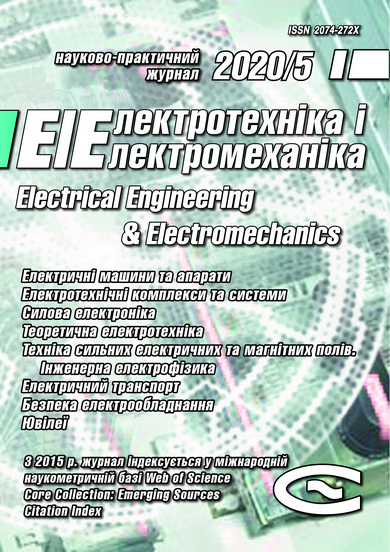ON THE SIMILARITY OF PLANE PULSED MAGNETIC FIELDS CONTINUED FROM DIFFERENT COORDINATE AXES
DOI:
https://doi.org/10.20998/2074-272X.2020.5.07Keywords:
plane magnetic field, sharp skin-effect, Cauchy problem for Laplace equation, similarity theoryAbstract
Purpose. The purpose of this work is formulation of similarity conditions for plane magnetic fields at a sharp skin-effect continued in non-conducting and non-magnetic medium from different axes bounding plane surfaces of conductors. Methodology. Classic formulation of Cauchy problem for magnetic vector potential Laplace equations, mathematic physics methods and basics similarity theory are used. Two problems are considered: the problem of initial field continuation from one axis and the problem of similar field continuation form other axis on which magnetic flux density or electrical field strength in unknown. Results. Necessary and sufficient similarity conditions of plane pulsed or high-frequency magnetic fields continued from different axes of rectangular coordinates are formulated. For the given odd and even magnetic flux density distributions on axis of initial field corresponding the distributions on axis and solution of continued similar field problem are obtained. Originality. It is proved that for similarity of examined fields the proportion of corresponding vector field projections represented by dimensionless numbers in similar points of axes is necessary and sufficient.References
Belyj I.V., Fertik S.M., Himenko L.T. Directory of magnetic-pulse treatment of metals. Kharkov, Vysshaia shkola Publ., 1977. 168 p. (Rus).
Shneerson G.A. Fields and transients in equipment ultra strong currents. Moscow, Energoatomizdat Publ., 1992. 416 p. (Rus).
Gurbanov G.G., Kas'iankov P.P., Taganov I.N. Propagation of the field potential along a given distribution on the axis. Radio engineering and electronics, 1967, no. 4, pp. 659-661. (Rus).
Mikhailov V.M. Shapes determination of the electrodes and coils to generate predetermined field distributions. Technical electrodynamics. Thematic issue «Problems of modern electrical engineering», 2000, part 6, pp. 13-16. (Rus).
Tozoni O.V. Calculation of electromagnetic fields on computers. Kiev, Tekhnika Publ., 1967. 252 p. (Rus).
Kirpichev M.V., Konakov P.K. Mathematical foundations of similarity theory. Moscow-Leningrad, Acad. of Sci.USSRPubl., 1949. 104 p. (Rus).
Eigenson L.S. Modeling. Moscow, Sovetskaia nauka Publ., 1952. 372 p. (Rus).
Venikov V.A., Venikov G.V. The theory of similarity and modeling (in relation to the problems of the electric power industry). Moscow, Vysshaia shkola Publ., 1984. 439 p. (Rus).
Vasetskii Iu.M., Vlasov D.I., Konovalov O.Ia., Mikhailov V.M. Some solutions to the problem of continuation of a plane field in elementary functions. Proceedings of the conference SIMULATION-2012,Kiev, 2012, pp. 232-236 (Rus).
Valery Mikhailov, Mykyta Petrenko. Inductor shape determination for electromagnetic forming of sheet workpieces. Przeglad Elektrotechniczny, 2020, no. 1, pp. 74-77. doi: 10.15199/48.2020.01.18.
Gradshtein I.S., Ryzhik I.M. Tables of integrals, sums, series and products. Moscow, Nauka Publ., 1971. 1108 p. (Rus).
Downloads
Published
How to Cite
Issue
Section
License
Copyright (c) 2020 V. M. Mikhailov

This work is licensed under a Creative Commons Attribution-NonCommercial 4.0 International License.
Authors who publish with this journal agree to the following terms:
1. Authors retain copyright and grant the journal right of first publication with the work simultaneously licensed under a Creative Commons Attribution License that allows others to share the work with an acknowledgement of the work's authorship and initial publication in this journal.
2. Authors are able to enter into separate, additional contractual arrangements for the non-exclusive distribution of the journal's published version of the work (e.g., post it to an institutional repository or publish it in a book), with an acknowledgement of its initial publication in this journal.
3. Authors are permitted and encouraged to post their work online (e.g., in institutional repositories or on their website) prior to and during the submission process, as it can lead to productive exchanges, as well as earlier and greater citation of published work.





